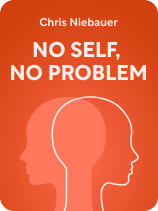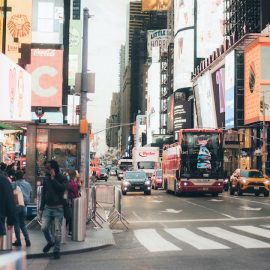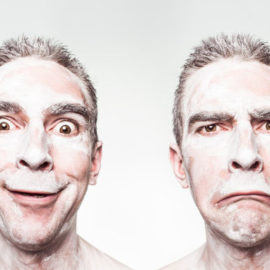

This article is an excerpt from the Shortform book guide to "No Self, No Problem" by Chris Niebauer. Shortform has the world's best summaries and analyses of books you should be reading.
Like this article? Sign up for a free trial here.
Do you ever feel like you don’t have a consistent self? Have you considered that your sense of self might be an illusion created by your brain?
Neuroscience is shedding new light on the nature of the self. In his book No Self, No Problem, Chris Niebauer explores how recent findings in neuroscience align with ancient Buddhist teachings about the illusory nature of the self.
Read more to learn Niebauer’s fascinating findings about neuroscience and the self.
Neuroscience and the Self
Niebauer’s specialty is neuroscience and the self. In his assessment, neuroscience is finally catching up to what Buddhist teachers discovered thousands of years ago about the nature of the self: that it isn’t real. We’ll examine what new research suggests about how the brain constructs your sense of self, using the unique capabilities of its left hemisphere and right hemisphere to convince you that you have a real and permanent self. Then, we’ll explore Niebauer’s argument that these scientific studies reveal that your self-concept doesn’t correspond to something real or permanent—just like Eastern thinkers have taught for thousands of years.
(Shortform note: Philosopher and Waking, Dreaming, Being author Evan Thompson agrees with Niebauer that Buddhism and neuroscience both show the self isn’t so much an entity as an experience. Thompson says the two coincide on other points, too: For example, studies support the Buddhist idea that we can train our thinking with meditation. Neuroscience may even agree with Buddhists that our consciousness works when we’re asleep, which is when the brain processes information to encode experience into memory. But Thompson quibbles with the characterization, by Buddhists and neuroscientists, of the self as an illusion: He says it’s more accurate to call it a “construction,” since the experience is very real.)
First, a Crash Course in Brain Anatomy
Before we dive into how your brain constructs your sense of self and convinces you it’s real, it’s important to know that the brain consists of a left hemisphere (the “left brain”) and a right hemisphere (the “right brain”). The two communicate with each other via a bundle of nerve fibers called the corpus callosum, which runs between them. Each side of the brain looks like a mirror image of the other. But neuroscientists have learned the two are actually quite different: Each side of the brain has a different set of capabilities, and certain cognitive tasks rely more strongly on one side of the brain than the other.
The left brain and the right brain each make a unique contribution to your belief in your sense of self, and Niebauer suggests the self is just a story that your narrative-driven left brain continuously weaves. But if you can step away from the narratives your left brain constructs, you can tap into your right brain—the part of your brain that experiences the world in real time—and realize you have no consistent “self” at all, just experiences happening in the present moment.
(Shortform note: As Niebauer states, some cognitive functions take place more on one side of the brain than the other, a phenomenon called lateralization. For most tasks, the two sides work together, but one may take the lead: For example, the right often dominates in perceiving faces. Some experts think vertebrates’ brains have been lateralized for 500 million years, far longer than humans have existed. The left brain may have originally controlled routine behavior in ordinary situations, while the right brain managed novel situations. This suggests the left brain evolved to manage self-motivated behavior and the right for environmentally-motivated behavior—an addition to Niebauer’s statement that the self arises from the left brain.)
The Left Brain Creates the Self by Building Stories From Our Experiences
The left brain works to make sense of the world. Niebauer explains that it creates a continuous story to explain what we experience, how we behave, and who we are. This story creates our sense of self. Telling a story involves building sequences and categories of events and information. So the left brain is often thinking about what happened in the past and what might occur in the future, rather than living in the present.
Niebauer explains that, to fit everything we know about ourselves and our lives into a comprehensive narrative, the left brain constantly works to explain what’s going on, what we’re doing, and what we’re thinking. The left brain comes up with a story to explain what it observes, even when it has absolutely no idea why things are the way they are. Niebauer explains that it’s also completely convinced the explanations it comes up with are correct, even when they aren’t based on reality and in fact often do a bad job of explaining what we observe.
According to Niebauer, the left brain has the odd tendency to fluently explain our actions even when it has no idea why we’re behaving as we are. To demonstrate how this works, he cites the example of people called “split-brain patients,” who have had their corpus callosum severed to treat severe epilepsy and reduce the intensity of the debilitating seizures it causes. When the right brain of a split-brain patient follows instructions the left brain can’t access, the left brain doesn’t admit it doesn’t know why the person is completing an action. Instead, it invents (and believes) a story to explain the behavior.
Niebauer explains that the left brain uses two tools to create the narratives and sense of self that shape how we perceive our world: language and pattern recognition. We’ll look at the details of each of these next.
Language
The left brain is the dominant side of the brain for the use of language. It produces the internal monologue many people hear in their heads. Through this monologue—which sounds like “you” talking to yourself within your mind—your left brain gives a voice to your observations, thoughts, and judgments. These are all, by nature, subjective, and often wrong. But because the left brain puts them into language, they feel real.
Because language makes them feel real, you usually don’t question the left brain’s explanations, whether in your inner monologue or in your thoughts and judgments. Niebauer argues this leads to negative experiences, like when your left brain convinces you your best friend is upset at you or talks you into believing you failed an exam, even though it doesn’t have compelling evidence for either story.
Another way the left brain’s facility with language leads us astray is by convincing us the categories and labels it comes up with are real. Niebauer explains the left brain is so invested in the reality of the language it uses to describe the world that it sometimes thinks the abstractions and arbitrary categories it dreams up are real or definitive—but they aren’t. For instance, your brain might label the people in your life as “good” or “bad” and assume they’ll always act accordingly. But in reality, everyone’s behavior and moral character is nuanced—and most people believe that doing one good or bad thing doesn’t make someone a good or bad person.
Pattern Recognition
Intrinsic to the left brain’s ability to produce language and construct categories is another key function of this half of the brain: its tendency to search for patterns. Niebauer notes that we see patterns everywhere, even where none actually exist. That’s what causes the left brain to separate things into categories, make judgments, and apply labels, often erroneously.
Niebauer says the tendency to search for patterns—and to find them, whether they’re real or not—contributes to our belief in the self. When the left brain looks at our thoughts, memories, and preferences, it looks for connections in these enormous sets of information. The pattern that emerges is the self. The self is wildly convincing to the left brain, but that doesn’t mean it’s real.
The Right Brain Lives In the Present Moment—But the Left Brain Doesn’t
While the left brain is constantly talking to itself—judging, sequencing, categorizing, and labeling everything we experience—the right brain approaches reality differently. Niebauer states that the right brain experiences the world without the constraints of language because while it understands language, it can’t produce language. Instead, the right half of your brain perceives the world more directly, without the filter of the left half’s narratives.
Niebauer explains that the right brain and the left brain are constantly sharing what they’re learning and doing. The left brain does this in words, which gives you the ability to consciously think about what you’re doing. But Niebauer notes that, because the right brain can’t “speak” to the left brain in words, it leaves the left brain in the dark as to what it’s doing. So the left brain labels many of the activities of the nonverbal right brain “unconscious,” even ones that involve choice and complex thinking.
While the right brain’s ability to think and act without language creates some odd effects in its collaboration with the left, it comes with benefits, too. Niebauer explains that the right brain’s ability to think without the constraints of verbal language gives us several kinds of nonverbal knowledge: intuition, emotions, plus a more holistic way of making sense of the world than the narrative-based method of the left brain.
Intuition and Emotions
Our decisions are often influenced by nonverbal knowledge that comes from the right brain. That includes the kind of nonverbal knowledge we call “intuition.” As Niebauer explains it, intuition feels like having knowledge about something but not being able to articulate where this knowledge came from. That’s exactly how our intuitions come about: When the right brain sends information to the left, the left brain can’t place where it came from. So it calls it an intuition.
Intuition plays an important role in our emotions, which are also associated with the right brain, according to Niebauer. One emotion in particular—gratitude—both illustrates how the right brain sees the world and explains how the right brain’s way of seeing the world can dissipate the illusion of the self. Niebauer explains we feel something like the opposite of gratitude when we judge our experiences. The left brain labels them “good” or “bad,” and when we hold onto these judgments, they reinforce the illusion that we’re a separate “self” interacting with the world. But when we practice gratitude, the right brain takes over and we can accept reality as it is, without judging it, and appreciate what we experience in the present moment.
Seeing Things as Connected, Rather Than Separate
Niebauer explains that the right brain takes a holistic view of the world, enabled in part by emotions like compassion. Buddhists understand compassion as an ability to see how everyone is connected. So it’s no surprise that while your left brain considers you an individual separate from everyone else, the compassionate right brain can see everything and everyone as interconnected, rather than as separate entities.
The right brain’s ability to see connections means that while the left brain sees everything you experience as a series of separate events and focuses on specific observations or perceptions, the right brain views things holistically. Niebauer explains that the right half of your brain treats experiences and pieces of information as if they’re all connected to one another and develops comprehensive impressions rather than thoughts or judgments pinned to specific pieces of information.
Is the Left Brain or the Right Brain Correct? Why Does It Matter?
The evidence is looking pretty compelling that there’s a difference between your left brain and your right brain’s visions of the world. The left brain’s efforts to make sense of the world create your sense of self, and the right brain’s way of thinking pokes some big holes in the left brain’s story. But, is that enough to throw out the narrative altogether? Niebauer contends another key piece of evidence from neuroscience research seems to rule out the existence of the self as an objective reality—and to show that believing the self is real causes us suffering we don’t have to experience.
While neuroscientists have identified regions of the left brain and right brain that seem to be responsible for specific tasks, Niebauer states that one region that so far remains conspicuously absent from our map of the brain is a center for the self. One crucial quality unites the cognitive functions—like language, face perception, or understanding others’ emotions—neuroscientists have mapped to specific parts of the brain: Because these cognitive tasks depend in part on specific brain regions, they seem to be performed the same way each time. Niebauer argues the task of creating the self isn’t consistent in the same way.
(Shortform note: It’s tempting to look for distinct regions of the brain, located in one or both hemispheres, that seem responsible for a given task, as Niebauer implies. But scientists say many functions don’t just take place in just one region of the brain, and the idea that regions operate as independent “modules” has been criticized as “modern phrenology.” Many scientists observe that typically, cognitive tasks require the coordination of networks of different brain regions. These interact with each other to perform processes that, as Niebauer notes, tend to happen roughly the same way each time. Some scientists compare the brain to an orchestra: Each instrument has a part to play, but it’s only in their collaboration that a symphony emerges.)
Niebauer argues that the fact that neuroscientists haven’t discovered a brain region responsible for our sense of self seems to confirm that the self doesn’t persist over time (or even exist in the brain) in the way we feel it does. He explains that in this way, neuroscience suggests the individual self isn’t a stable reality but instead is just an idea—just as Buddhism and other Eastern schools of thought have taught for thousands of years.
(Shortform note: Scientists have several theories about where in the brain the self arises, like the idea it originates in the self-related thinking of the default mode network and cortical midline structures (CMS). Another theory says a region called the anterior precuneus gives us a sense of our physical self, creating a conscious “I” to accompany the “me” produced by the default mode network. Yet another hypothesis suggests the medial prefrontal cortex, a part of the default mode network, might create your sense of self by integrating what you know about your present and future selves. As Niebauer notes, scientists haven’t found conclusive evidence yet—but many do think you might find your “self” by looking at your brain.)
Niebauer also hypothesizes that consciousness, like the self, might not really exist in the brain, either: Instead, your brain might participate in a kind of “universal consciousness” present in all of us. Niebauer explains that just as we accept the illusion that we have a permanent and individual self, we also take it for granted that we have an individual consciousness, with our own perceptions and memories. But by holding on to these ideas, we prevent ourselves from entertaining the possibility that consciousness might not be something we have, but something we participate in, along with everyone else in the world.
(Shortform note: In Power vs. Force, psychiatrist David Hawkins describes universal consciousness as a kind of understanding or knowledge that everyone shares, somewhat like the “collective unconscious” Carl Jung proposed. Unlike Jung, Hawkins characterizes universal consciousness as both internal, in that we can access it within our own psyche, and external, in that it’s a single entity we all tap into. Hawkins contends that the most enlightened state we can achieve is one where we don’t see ourselves as individuals, but as extensions of the universal consciousness—a description of enlightenment that accords well with the teachings of Hinduism.)
So why does all of this matter? Niebauer explains accepting the self as real isn’t a harmless error, but often makes us anxious, unhappy, or dissatisfied in our lives. He notes that when we identify our sense of self (and our sense of reality) too strongly with our thoughts, feelings, and judgments, then we take those thoughts and feelings too literally.
When we believe what we’re thinking or feeling is literally true, then we assume that thoughts like, “I can’t do anything right,” or “Things will never work out the way I want” tell us something true or real about the world. So we experience what Buddhists call “suffering.” Suffering involves a sense of dissatisfaction with the way things are, either in the world around us or in our inner worlds. We experience it so much that it feels like an inescapable part of life.
(Shortform note: Niebauer argues the self isn’t real, but suffering is—a view shared by A Swim in a Pond in the Rain author George Saunders. Saunders, a longtime student of Nyingma Buddhism, explains that if we realized the impermanence of everything and the delusion of our “self-loyalty,” we wouldn’t experience the pain we feel when reality doesn’t line up with our expectations—the pain Buddhists call “suffering.” For example, Saunders explains that when we encounter something, whether a person or a paragraph, we have a visceral reaction to it. This reaction is real, and we only create suffering for ourselves when we try to deny it or change it. Instead, we have to look at our thoughts and feelings and just accept whatever we see.)
Niebauer contends that, by working to loosen your grip on your traditional idea of the self, you can work toward the freedom from suffering that countless students of Buddhism have sought. And you can do that while still enjoying the ups and downs of daily life lived from the perspective of the self you’ve always known.

———End of Preview———
Like what you just read? Read the rest of the world's best book summary and analysis of Chris Niebauer's "No Self, No Problem" at Shortform.
Here's what you'll find in our full No Self, No Problem summary:
- Why everything you know about yourself is wrong
- How science is catching on to what Eastern religions have been teaching for millenia
- How to loosen your grip on the thoughts and judgments that make you dissatisfied with your reality






